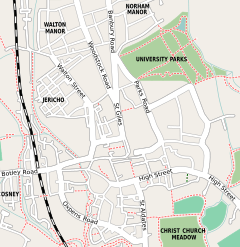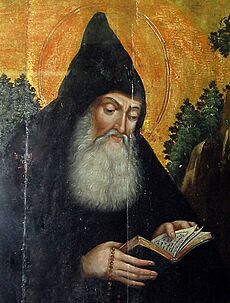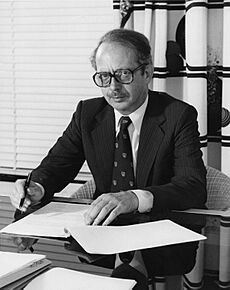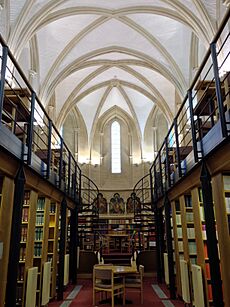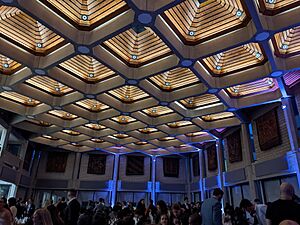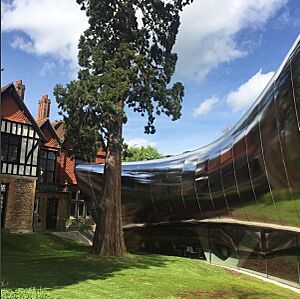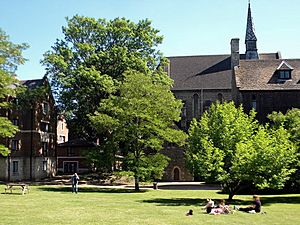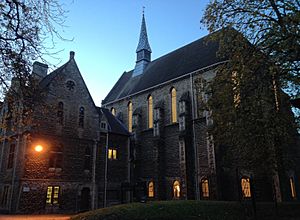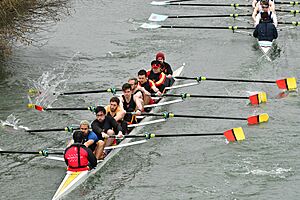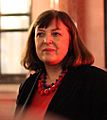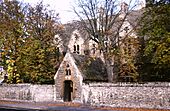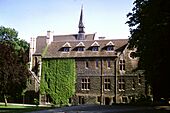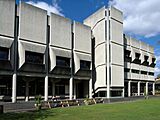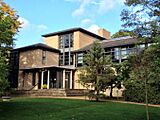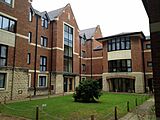St Antony's College, Oxford facts for kids
Quick facts for kids St Antony's College |
||||||||||||||||||||||
|---|---|---|---|---|---|---|---|---|---|---|---|---|---|---|---|---|---|---|---|---|---|---|
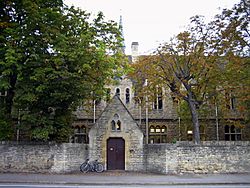
Entrance to the old building at St Antony's College
|
||||||||||||||||||||||

Blazon: Or on a chevron between three tau crosses gules as many pierced mullets of the field.
|
||||||||||||||||||||||
|
|
||||||||||||||||||||||
| University | University of Oxford | |||||||||||||||||||||
| Location | Between Woodstock Road, Bevington Road, Church Walk, and Winchester Road | |||||||||||||||||||||
| Coordinates | 51°45′47″N 1°15′46″W / 51.763149°N 1.262903°W | |||||||||||||||||||||
| Latin name | Collegium Sancti Antonii | |||||||||||||||||||||
| Motto | Plus est en vous | |||||||||||||||||||||
| Motto in English | There is more in you | |||||||||||||||||||||
| Established | 1950 | |||||||||||||||||||||
| Named for | St Antony of Egypt | |||||||||||||||||||||
| Sister college | Wolfson College, Cambridge | |||||||||||||||||||||
| Warden | Roger Goodman | |||||||||||||||||||||
| Undergraduates | None | |||||||||||||||||||||
| Postgraduates | 443 (2018/2019) | |||||||||||||||||||||
| Boat club | SABC | |||||||||||||||||||||
| Map | ||||||||||||||||||||||
St Antony's College is a special college that is part of the University of Oxford in England. It was started in 1950 thanks to a generous gift from a French businessman named Sir Antonin Besse.
St Antony's focuses on advanced studies for students who have already finished their first university degree. These studies include international relations (how countries get along), economics (how money and resources work), politics (how governments work), and area studies. Area studies means learning deeply about specific parts of the world like Europe, Russia, Latin America, the Middle East, Africa, Japan, China, and South and South East Asia.
The college is located in North Oxford. It became a place for both men and women to study in 1962.
Contents
History of St Antony's College
St Antony's College was founded in 1950. It all started with a big gift from Sir Antonin Besse, a rich merchant from France.
In 1947, Sir Antonin wanted to give about £2 million to the University of Oxford to create a new college. At first, the university wasn't sure. They suggested he help some older, less wealthy colleges instead. Sir Antonin did give money to several existing colleges. After this, the university changed its mind. They saw a need for a new college, especially for students doing advanced degrees (called "postgraduate" students). So, in 1948, Sir Antonin signed the papers to officially start the college.
The university then looked for a permanent home for the new college, which was named St Antony's. After looking at several places, they finally found the current location at 62 Woodstock Road in 1950.
The first students came to St Antony's in 1950. The college officially received its special permission (called a Royal Charter) in 1953. In 1962, another charter allowed women to join the college. By 1963, St Antony's became a full member of the University of Oxford. By 1952, there were 27 students, and by the end of the 1950s, there were 260 students from 34 different countries!
The college faced some money problems in its early years. However, under the leadership of William Deakin, the college raised money from groups like the Ford and Volkswagen foundations. Since then, St Antony's has grown and opened new centers for studying different parts of the world. Today, it is known as one of the best places in the world for these "area studies." It has centers for studying Africa, Asia, Europe, Japan, Latin America, the Middle East, and Russia and Eurasia.
From the very beginning, Sir Antonin Besse wanted the new college to be open to everyone, no matter where they came from or what they believed. He hoped it would help people from different countries work together and understand each other better. The college's main goal became to be a place for advanced study in history, philosophy, economics, and politics, and to be an international center where students from all over the world could live and learn together.
St Antony's is still very true to this idea. It is one of the most international colleges at Oxford. Because it focuses on specific regions and had a strong reputation for studying the Soviet Union during the Cold War, some people even joked about it being a "spy college." This was just a rumor, but it shows how important the college was for understanding international affairs.
The college's name, St Antony's, comes from its founder, Antonin Besse. For a while, people weren't sure if it was named after Anthony the Great or Anthony of Padua. In 1961, it was decided that Anthony the Great was the right choice. This was because he had links to the Middle and Near East, which is one of the college's main study areas. Even so, the college celebrates both saints' days each year, and a statue of Anthony of Padua is in one of the college buildings.
Buildings and Grounds at St Antony's
The Main Building
The main building of St Antony's College was built a long time ago, in the early Victorian era. It was first a convent for a group of nuns. A local architect named Charles Buckeridge designed the building. The convent opened in 1868.
The building cost a lot of money back then. In 1950, St Antony's College took over the building. The chapel of the old convent, which was never used as a church, is now the college library. The basement of the main building, now called the Gulbenkian Reading Room, was once the nuns' dining room.
The Hilda Besse Building (1960s)
After some big plans to expand the college in the 1960s didn't happen due to lack of money, the college built a smaller extension. The Hilda Besse Building opened in 1970. This building is still used for the college's dining hall, the common room for graduate students, and the college bar. It also has meeting rooms.
Later, in 1993, a new building was completed for the Nissan Institute for Japanese Studies and the Bodleian Japanese Library. More student rooms were added in the Founder's Building, which opened in 2000. The main dining hall, the Wahba Dining Hall, was even used as a filming location for a movie!
The Gateway Buildings (2000s)
In the early 2000s, the college built the new Gateway Buildings, which were finished in 2013. These buildings create a new main entrance for the college. They also complete the first main courtyard of the college.
The Investcorp Building
As part of its growth, St Antony's also built a new center for Middle Eastern Studies. This building, called the Investcorp Building, was designed by a famous architect named Zaha Hadid. It opened in 2015. It has a very modern and unique design.
Student Life and Study
St Antony's College has about 450 students from more than 66 different countries. About half of the students speak a language other than English as their first language. Students have a group called the Graduate Common Room (GCR) Executive, which is elected each year to represent their interests.
Most students live at the college. There are about 104 rooms with private bathrooms in the Gateway and Founder's buildings. More rooms are in old Victorian houses nearby that have been changed for students.
The college has a bar called St Antony's Late Bar. It's on the ground floor of the Hilda Besse building. Besides being a bar, it hosts many fun events like themed parties, cultural nights, live music, and charity events. Some regular events include Halloqueen and USA Night.
Libraries and Publications
The old Main Building has the College Library and the Russian and Eurasian Studies Centre Library. The College Library has books on modern history, politics, international relations, and economics. It has over 50,000 books and many old magazines. It also has some old collections of papers from the 1900s.
Other libraries at the college include the Middle East Centre Library, the Bodleian Latin American Centre Library, and the Bodleian Japanese Library. These libraries are special because they have many books and materials in different languages from specific regions of the world. They are often open to all students at the university, not just those from St Antony's.
The college's student group, the Graduate Common Room, publishes a journal twice a year called the St Antony's International Review (STAIR). This journal lets young academics publish their work alongside more experienced experts. The college also publishes a newsletter called the Antonian and an annual report about college news.
Sports and Societies
Students at St Antony's enjoy a lively social life. The St. Antony's College Boat Club has several rowing boats and has done well in Oxford's rowing races. The football club is also very popular. There is also a gardening club and other groups for students to join.
Rankings
St Antony's is a college only for postgraduate students. This means it doesn't appear in the university's yearly Norrington Table, which ranks colleges based on undergraduate exam results.
Traditions and Attributes
St Antony's is a fairly relaxed college. Students only need to wear special academic clothes (called sub fusc) for important university events like starting college and graduation. The college doesn't have a permanent "high table" for professors. Instead, special meals are held a few times a week where professors and visiting scholars can eat. Students are often invited to these meals by their teachers.
Coat of Arms
The college's coat of arms (its special symbol) was given in 1952. It shows symbols related to the college's namesake, Anthony the Great of Egypt. The red color stands for the Red Sea, and the gold color represents the desert sands. The stars on the shield come from the founder's (Sir Antonin Besse's) business symbol. The T-shaped symbols are traditional crosses of St Antony.
The college's motto is 'plus est en vous'. This French phrase means "there is more in you." It suggests that people have more potential than they might realize.
Grace
St Antony's is one of nine colleges at Oxford that uses a short, two-word Latin grace before and after meals. This is a common tradition in Oxford and Cambridge universities. The grace is said in two parts during formal meals, which happen three times each term.
The first part, Benedictus benedicat, is said before the meal. It means "May the Blessed One give a blessing." The second part, Benedicto benedicatur, is said after the meal. It means "Let praise be given to the Blessed One."
This grace is said to keep with tradition. However, unlike most Oxford colleges, students at St Antony's don't have to stand up when the grace is said.
People Associated with St Antony's
Wardens
The Warden is the head of the college. The first Warden was Sir William Deakin (1950–1968). He was a young academic who became a soldier and helped Winston Churchill during World War II. He worked closely with Sir Antonin Besse to make the college a great place.
Sir Raymond Carr (1968–1987) was a famous historian of Spain. He helped the college grow and welcomed scholars from all over the world.
Sir Ralf Dahrendorf (1987–1997) was a well-known thinker and politician from Germany. He also helped the college expand and become a source of advice on important policies.
Sir Marrack Goulding (1997–2006) worked for the British government and then for the United Nations. His leadership showed how international the college is and its connections to governments and businesses.
After Margaret MacMillan retired in 2017, Roger Goodman became the current Warden.
- Sir William Deakin, 1950–68
- Sir Raymond Carr, 1968–87
- Sir Ralf Dahrendorf (later Lord Dahrendorf), 1987–97
- Sir Marrack Goulding, 1997–2006
- Roger Goodman, (acting), October 2006–July 2007
- Margaret MacMillan, 2007–17
- Roger Goodman, 2017–
Former Students
Many former students of St Antony's College, called Antonians, have become very successful in different jobs. They include writers, politicians, professors, and many people who work for governments or international groups.
Some famous politicians and government workers who studied here include Guðni Th. Jóhannesson, the President of Iceland, and Álvaro Uribe, who was President of Colombia. Others include Chrystia Freeland, the Deputy Prime Minister of Canada, and Olli Rehn, a former Vice President of the European Commission.
In the world of academics, many Antonians have become leading professors at top universities around the world. These include Sir Christopher Bayly at Cambridge, Wm. Roger Louis at the University of Texas, and Craig Calhoun, a former director of the London School of Economics.
The college's alumni also include an Olympic gold medal swimmer, a violinist, a screenwriter, and the historian Margaret MacMillan.
Academics
Many important scholars and experts have taught at St Antony's College. Here are a few:
- Timothy Garton Ash, a journalist and writer about Europe.
- Archie Brown, a historian who wrote about the end of the Cold War.
- Paul Collier, who studies African economies.
- Eugene Rogan, a historian of the Modern Middle East.
- Robert Service, a historian who wrote about the USSR and famous leaders like Vladimir Lenin and Joseph Stalin.
- Avi Shlaim, a historian who writes about the conflict between Arabs and Israelis.
Former Fellows
Some notable former fellows (senior members) of the college include:
- Michael Herman, who started the Oxford Intelligence Group.
- Foulath Hadid, an Honorary Fellow.
- Albert Hourani, who founded the Middle East Centre at the college.
- James Joll, a historian.
- Michael Aris, an expert on Bhutanese and Tibetan culture, and husband of Aung San Suu Kyi.
Gallery
See also
 In Spanish: St Antony's College (Oxford) para niños
In Spanish: St Antony's College (Oxford) para niños


